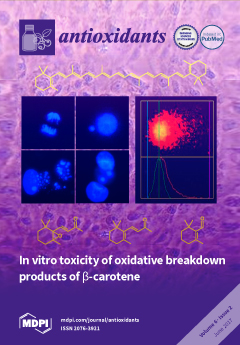Open AccessArticle
Green Synthesized Zinc Oxide (ZnO) Nanoparticles Induce Oxidative Stress and DNA Damage in Lathyrus sativus L. Root Bioassay System
by
Kamal K. Panda 1, Dambaru Golari 1, A. Venugopal 1, V. Mohan M. Achary 2, Ganngam Phaomei 3, Narasimham L. Parinandi 4, Hrushi K. Sahu 5,† and Brahma B. Panda 1,*
1
Molecular Biology and Genomics Laboratory, Department of Botany, Berhampur University, Berhampur 760007, Odisha, India
2
Plant Molecular Biology Group, International Centre for Genetic Engineering and Biotechnology, New Delhi 110067, India
3
Material Chemistry Laboratory, Department of Chemistry, Berhampur University, Berhampur 760007, Odisha, India
4
Division of Pulmonary, Allergy, Critical Care, and Sleep Medicine, Department of Medicine, Davis Heart and Lung Research Institute, Ohio State University College of Medicine, Columbus, OH 43210, USA
5
Condensed Matter Physics Division, Indira Gandhi Centre for Atomic Research, Kalpakum, Tamil Nadu 603102, India
†
Present address: C/92 Vidya Nilaya, Shanti Nagar, Goilundi, Berhampur 760004, India.
Cited by 61 | Viewed by 11342
Abstract
Zinc oxide nanoparticles (ZnONP-GS) were synthesised from the precursor zinc acetate (Zn(CH
3COO)
2) through the green route using the milky latex from milk weed (
Calotropis gigantea L. R. Br) by alkaline precipitation. Formation of the ZnONP-GS was monitored by
[...] Read more.
Zinc oxide nanoparticles (ZnONP-GS) were synthesised from the precursor zinc acetate (Zn(CH
3COO)
2) through the green route using the milky latex from milk weed (
Calotropis gigantea L. R. Br) by alkaline precipitation. Formation of the ZnONP-GS was monitored by UV-visible spectroscopy followed by characterization and confirmation by energy-dispersive X-ray spectroscopy (EDX), transmission electron microscopy (TEM), and X-ray diffraction (XRD). Both the ZnONP-GS and the commercially available ZnONP-S (Sigma-Aldrich) and cationic Zn
2+ from Zn(CH
3COO)
2 were tested in a dose range of 0–100 mg·L
−1 for their potency (i) to induce oxidative stress as measured by the generation reactive oxygen species (ROS: O
2•−, H
2O
2 and
•OH), cell death, and lipid peroxidation; (ii) to modulate the activities of antioxidant enzymes: catalase (CAT), superoxide dismutase (SOD), guaiacol peroxidase (GPX), and ascorbate peroxidase (APX); and (iii) to cause DNA damage as determined by Comet assay in
Lathyrus sativus L. root bioassay system. Antioxidants such as Tiron and dimethylthiourea significantly attenuated the ZnONP-induced oxidative and DNA damage, suggesting the involvement of ROS therein. Our study demonstrated that both ZnONP-GS and ZnONP-S induced oxidative stress and DNA damage to a similar extent but were significantly less potent than Zn
2+ alone.
Full article
►▼
Show Figures






